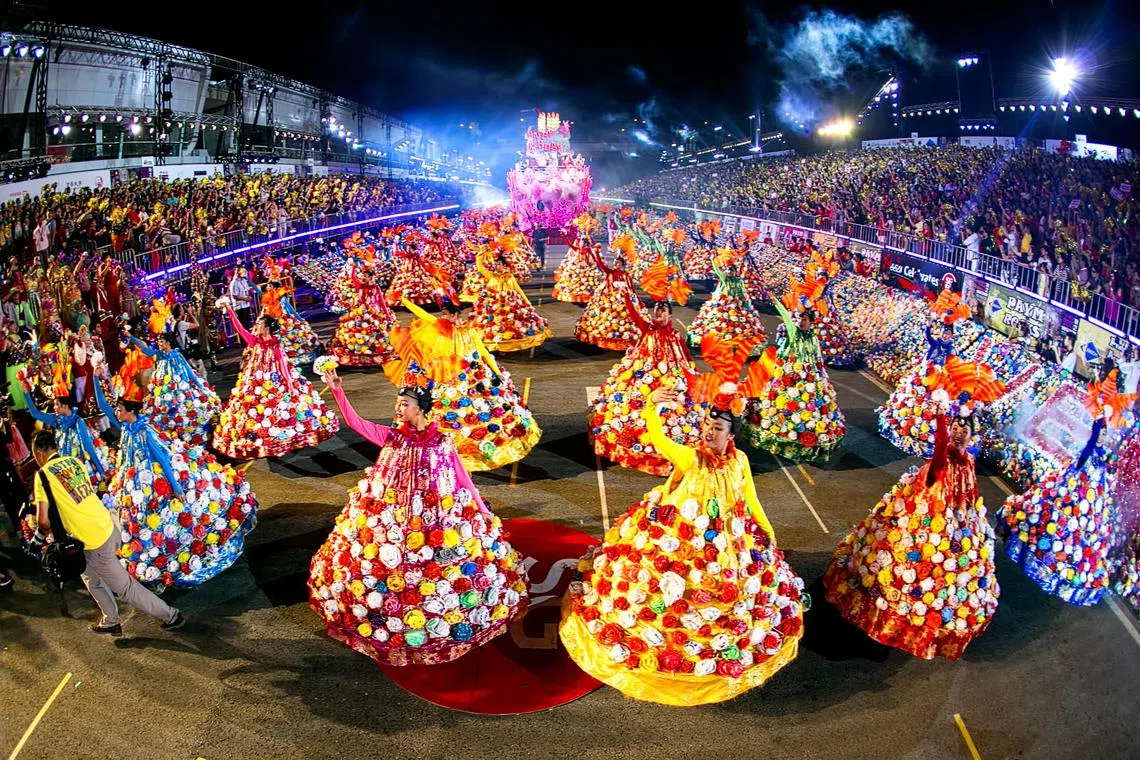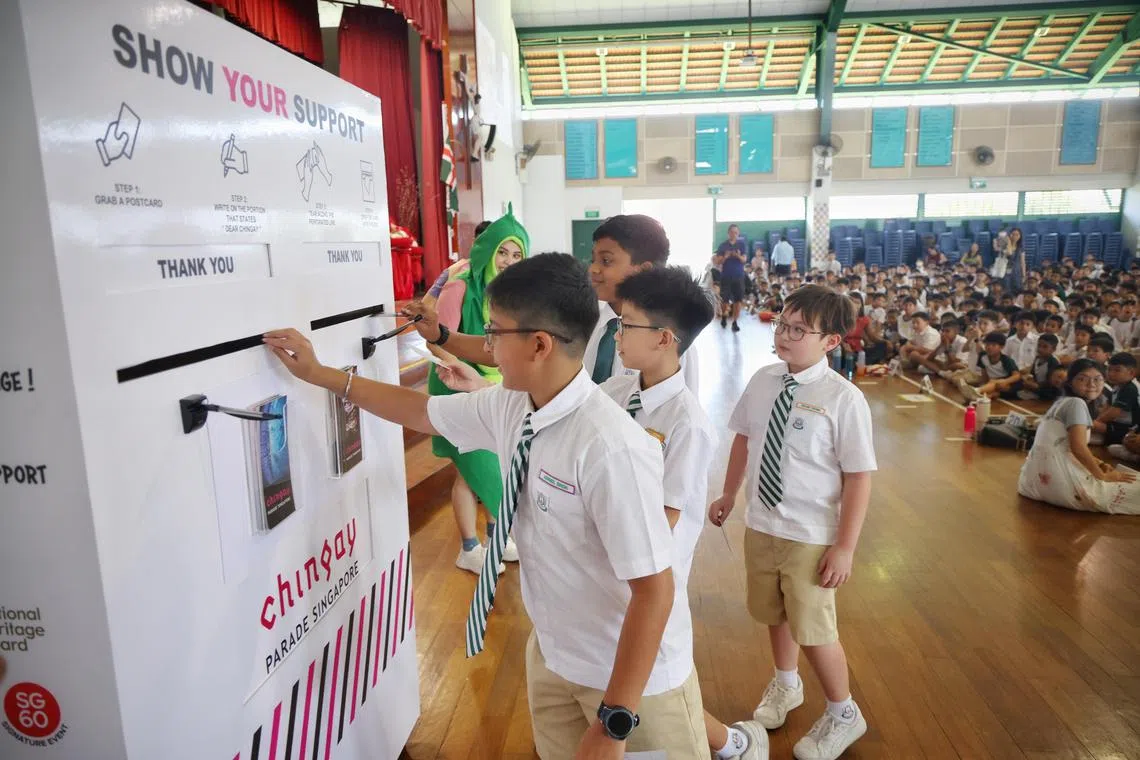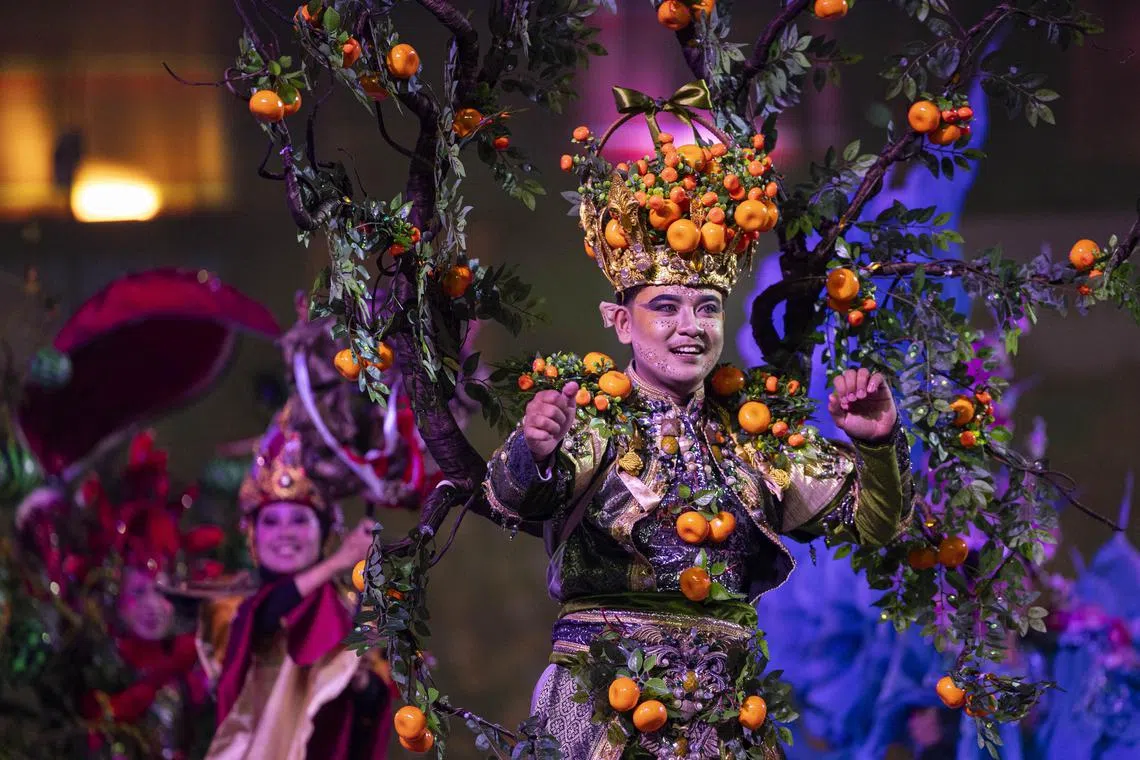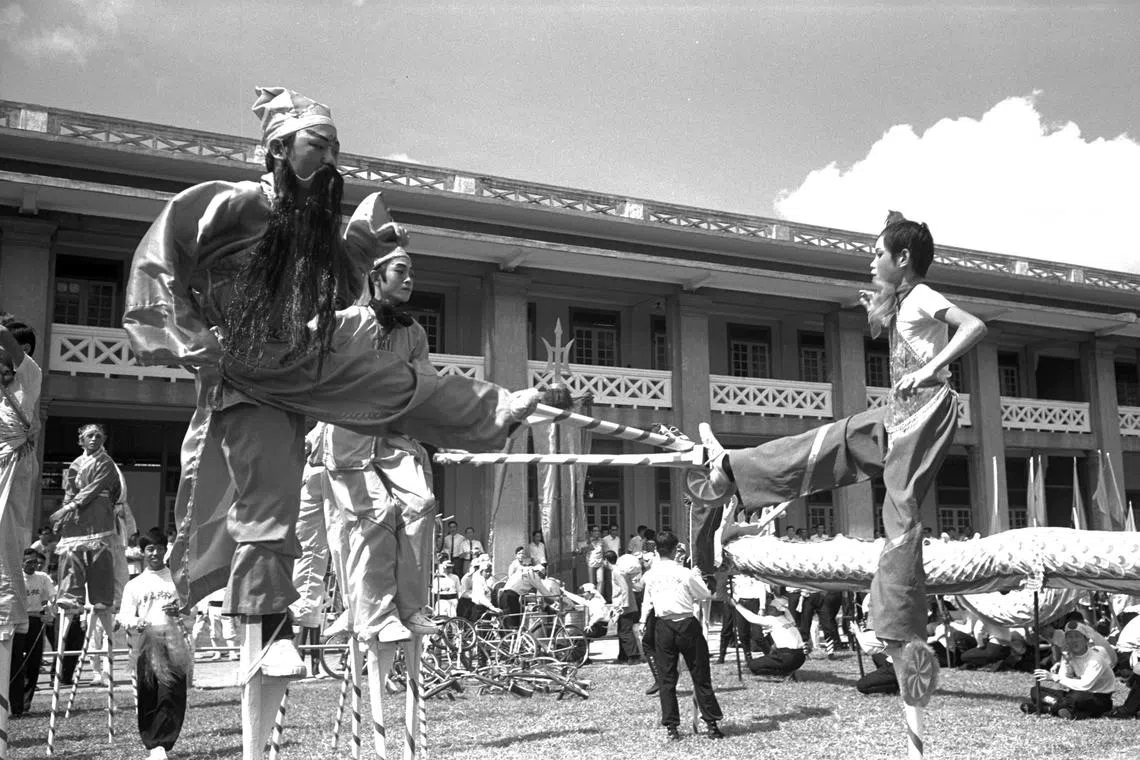Road to Unesco: How Chingay community is drumming up support for S’pore and Malaysia’s bid
Sign up now: Get ST's newsletters delivered to your inbox

Madam Tan Bee Lian and her son, Mr Arthur Ong, dressed as kueh tutu and ang ku kueh, respectively, at the Chingay Parade in 2025.
PHOTO: MR ARTHUR ONG
Follow topic:
SINGAPORE – For Chingay 2025, Mr Arthur Ong dressed up as an ang ku kueh.
In his nine years as a Chingay performer, the 40-year-old technical support executive has also danced with lotus flowers and helped to choreograph dances.
“One of my fond childhood memories was watching the Chingay performers give out candies and toys along Orchard Road in the 80s, perched on my dad’s shoulders,” said Mr Ong, who has been part of the Singapore Buddhist Federation’s Chingay contingent for several years. “I decided then that I wanted to be a performer one day.”
As Singapore and Malaysia prepare to nominate the street parade for Unesco’s intangible cultural heritage list in March, the People’s Association (PA) is hoping to spark a similar interest among children today.
Its efforts include exhibitions in schools, a storybook for pre-schoolers and even a Minecraft competition to design digital Chingay floats.
“Chingay is more than just a parade; it is a form of living heritage that continues to thrive, even after more than five decades,” said Ms Tan Swee Leng, vice-chairwoman for Chingay 2025.
The joint nomination for Unesco’s Representative List of the Intangible Cultural Heritage of Humanity will be Singapore’s third submission hawker culture the kebaya in December 2024.
Intangible cultural heritage refers to traditions or living expressions that are inherited and passed on between generations, such as performing arts, social practices, rituals and festive events.
The joint nomination is part of Singapore’s diamond jubilee celebrations in 2025, and also commemorates the 60th anniversary of ties between Singapore and Malaysia.

One million “We Love SG” flowers made by Singaporeans from recycled plastic bags to express good wishes for Singapore’s golden jubilee transformed the 2015 parade route into a breathtaking floral wonderland.
PHOTO: PEOPLE’S ASSOCIATION
“It’s about time,” said Mr Ong, whose 63-year-old mother Tan Bee Lian – dressed as a kueh tutu – performed in the 2025 parade with him.
“It’s in our heritage and blood... It shows the rich multicultural flavours of Singapore and Malaysia, so I’m sure we will succeed.”
PA told The Straits Times that more than 40 schools have indicated an interest in telling their students more about Chingay and its road to Unesco, and in having Chingay Unesco exhibits on their premises. The PA hopes to reach out to 30,000 students by March.
A book for pre-schoolers on the importance of volunteerism, multiculturalism and Chingay being a people’s parade will be launched in the second quarter of 2025. It will be given to major pre-school operators.
PA will also work with the National Library Board to conduct reading sessions during school holidays and roadshows, along with activities such as colouring.
In January 2026, a Minecraft Challenge will be introduced to allow primary and secondary school students who have access to Minecraft Education – a game-based learning platform – to develop floats in a virtual Chingay event.
PA has also been using its Chingay National Education Programme to amplify its Unesco campaign in schools.
Primary 4 pupil Ezra Siew was one of 47 boys from St Stephen’s School who attended the Chingay National Education Show – a parade preview – on Jan 18.

St Stephen’s School pupils (from left) Ashneil Singh, Vishal Raj, Ezra Siew and Oscar Thoms dropping postcards into a box during a Chingay engagement session at the school on Feb 3.
ST PHOTO: JASON QUAH
Said the nine-year-old: “It was very fun, colourful and creative. I really hope it will win the Unesco bid so that it will become more renowned in the world and be preserved as heritage.”
Mr P. Ramesh, assistant director of PA’s arts and culture division, said: “The schools have been very receptive as these shows help the students go from theory to practical and visual to understand more about Chingay. We need to start with these children from an early age to help them understand Singapore’s multiculturalism and diversity.”
The public can participate too, with PA recruiting volunteers and organising roadshows to drum up support for the Unesco nomination. More than 100 volunteers have signed up to tell the public more about Chingay at roadshows.
The first roadshow was held on Feb 7 and 8 at the F1 Pit Building. The roadshows will make the rounds to eight heartland sites, including Ang Mo Kio, Marsiling-Yew Tee and Pasir Ris-Punggol GRCs.
At these events, visitors can write messages on postcards and drop them into dedicated Chingay postboxes. The messages will be collated as part of the Unesco submission.
In addition, a Chingay exhibition truck is planned for the third quarter of 2025. One can expect to see historical photos, costumes and artefacts related to Chingay’s evolution, and information about the parade’s cultural significance.
An official microsite has been created at supportchingaysg.gov.sg for the public to leave real-time messages of support. It has garnered more than 500 messages so far.
And a series of six national stamps will be released if Chingay is successfully inscribed on Unesco’s intangible cultural heritage list.
The annual spectacle has attracted many fans since its 1973 debut.
One of them is Mr Romin Lim, 53, who started performing in the parades in 1985. Among his most memorable Chingay moments was when he performed as the God of Fortune along Orchard Road in 1999.
“Year after year, I found myself returning to support Chingay and each time, it felt like a heartfelt homecoming to familiar faces and a shared passion,” he said.
“With the nomination, I hope that more young people will step forward, not just to perform, but to experience the teamwork, dedication and friendships that make Chingay so unique,” he added.

Chingay performers at the F1 Pit Building on the second day of the parade on Feb 8.
ST PHOTO: BRIAN TEO
Ms Rasya Hanis Mohammad Nur’ Hidzat, 18, a production crew member with Chingay in 2024 and 2025, invited five of her friends to join her as volunteers in 2025. She has forged friendships with many others at the parade.
“Being recognised by Unesco would encourage more people to appreciate the different cultural traditions and diversity around the world that we get to showcase through Chingay,” she said.
The excitement is felt in Malaysia too.
Mr Ong Zhan Hao, 31, who is a special officer for the Penang state executive councillor for tourism and creative economy, said the whole Chingay community in Penang is looking forward to the joint submission.
Mr Ong, who was among 20 participants from Penang who participated in Chingay 2025 in Singapore, said: “Many have spent their whole life perfecting their skills and performances. If successful, we will finally gain recognition on the world stage.”
Chingay over the years
The name “Chingay” is derived from a Hokkien term equivalent to the Mandarin term zhuangyi, which means “the art of costume and masquerade”.
The first formal Chingay Parade in Singapore was mooted by founding prime minister Lee Kuan Yew, who was the former chairman of the People’s Association (PA). The celebrations compensated for the ban on setting off firecrackers, which was once a customary Chinese New Year practice to ward off evil spirits.
Held on Feb 4, 1973, the first Chingay saw PA teaming up with the Singapore National Pugilistic Federation to put up a grand parade. It featured various aspects of Chinese culture, including dragon and lion dances, martial arts and street opera in local dialects. It was so well received that PA made it an annual festival.

The first Chingay procession in Singapore was held on Feb 4, 1973.
PHOTO: NATIONAL ARCHIVES OF SINGAPORE
Chingay took on a multicultural flavour in 1976, featuring different ethnic communities joining the celebrations with cultural performances. These made Chingay a showcase of different communities living together harmoniously.
International flavour was injected in 1987 when The Straits Times sponsored four pop artistes from Tokyo to be part of the Chingay Parade.
In 2015, as part of the nationwide SG50 celebrations, Chingay presented the largest showcase in its history, with 11,000 performers and 18 floats.
In 2021, the first digital Chingay with the theme “Light of Hope” was held during the Covid-19 pandemic. The digital showcase, which was available online, involved more than 150 organisations and 2,000 performers.
In 2025, as part of SG60 celebrations, Chingay presented a special collaboration featuring 60 multi-ethnic drummers, percussionists and lion dance performers.

